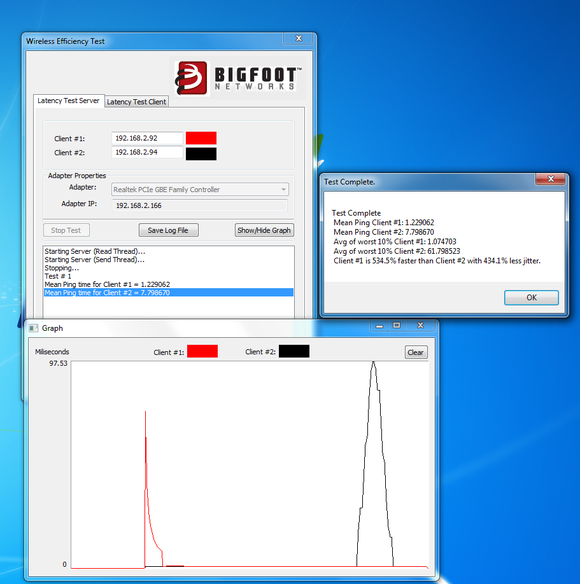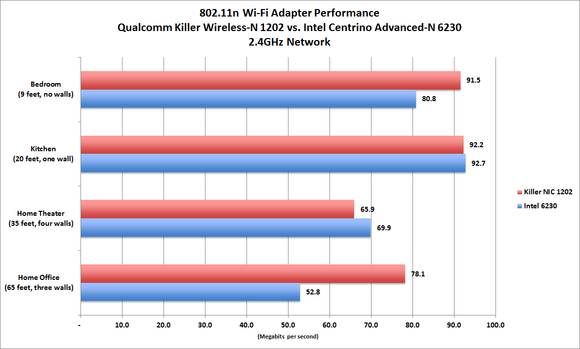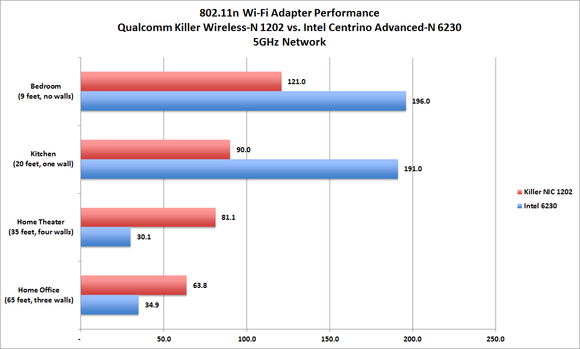Intel Dual Band Wireless-ac 3168 Review Range Low
At a Glance
Expert's Rating
Pros
- Very low latency and jitter
- Very fast TCP throughput at long range
- Handy collection of utilities
Cons
- Not compatible with newer, faster 802.11ac standard
- Supports only two spatial streams
Our Verdict
The Killer Wireless-N 1202 is a worthwhile upgrade for gamers and others who crave low-latency wireless network connectivity.
Gamers are e'er hunting for a competitive edge, and the folks at Bigfoot Networks—at present a function of Qualcomm Atheros—have long promised to deliver network interface cards that perform ameliorate with online games and other latency-sensitive applications. To demonstrate its prowess in this expanse, the company sent me two identical Alienware notebooks, one equipped with Qualcomm's Killer Wireless-N 1202 and the other with Intel'southward Centrino Advanced-N 6230.
 Robert Cardin
Robert Cardin Both NICs are dual-ring adapters that can connect to an 802.11n router on either the 2.4GHz or 5GHz frequency band. Both too support two spatial streams for a maximum physical link rate of 300 megabits per 2d. Some gaming-laptop manufacturers, including Alienware, offer Killer NICs as standard equipment, while others offer the adapters equally added-toll upgrades. Y'all can likewise purchase one of these cards by itself and upgrade your existing notebook, provided that the system has an available Mini PCIe slot to host the bill of fare (a common feature on better notebooks). The Killer Wireless-North 1202 is certainly cheap enough: I've seen it selling online for as little every bit $35 (Intel's carte du jour is street-priced at about $thirty).
The key selling indicate of Killer NIC technology is its ability to place the types of traffic traveling over your network and to assign higher priority to latency-sensitive traffic, such every bit online games, HD video, and audio.
Latency is a mensurate of time delay. When applications such as online games and streaming media meet besides much latency, you'll end upward with visible and/or audible glitches and hiccups. If y'all're playing a first-person shooter with an online opponent, latency can render you a frustratingly easy target.
To evaluate each card's ability to gainsay network latency, Qualcomm provided me with its Gaming Network Efficiency (GaNE) benchmark to measure ping (the time required for a packet to make a round trip on the network) and jitter (undesirable deviations in signal timing). Qualcomm offered to allow us to examine the plan's source lawmaking to ensure that there were no shenanigans.
Measuring ping and jitter using GaNE
GaNE measures real-time performance from two wireless clients at once, recording the results on a third computer that's hardwired to the network. This way, both customer adapters are subject to the same environmental conditions—an important variable when y'all're benchmarking wireless functioning. The tool measures latency between two networked PCs by sending a 100-byte package on a round trip over the network every 50 milliseconds (100 bytes is the typical packet size on gaming networks, and 50ms is the typical interval between packets on the aforementioned). I used my longtime favorite 802.11n Wi-Fi router, a dual-band Asus RT-N66U, for these tests.

I set the two wireless clients almost nine feet from the router in the aforementioned room, so no walls stood in between, and I continued them to the router'southward 2.4GHz network. I then performed vi runs of the GaNE benchmark. GaNE reported an average ping time for the Killer Wireless-N 1202 of nearly ane.v milliseconds, and an average ping of nearly iv milliseconds for the Intel menu. What'due south more than, GaNE measured one-and-a-half times more jitter with Intel'south card than it did with Qualcomm's. The Killer NIC delivered similar performance when I switched the clients over to the router's 5GHz network—slightly less than 2 milliseconds—but Intel's bill of fare registered a much higher boilerplate ping of nearly eight milliseconds.
TCP throughput
I also used the Asus RT-N66U to compare the adapters' TCP-throughput performance, using JPERF (the Java front to the TCP-throughput benchmark iPERF). The two adapters traded places on the 2.4GHz frequency band, but when the Killer Wireless-N 1202 won, it won by a significant margin. When the client was in the same room every bit the router, 9 feet away with no walls in between, it was ten.vii mbps faster than Intel's component. And when the customer was in my domicile function, 65 feet away and separated by three insulated interior walls, the Killer NIC was more than 25 mbps faster. At the two locations at which Intel's adapter prevailed—in the kitchen (twenty anxiety from the router) and in the home theater (35 feet from the router)—the margins were just 0.5 mbps and 4.0 mbps respectively.

When I tested each adapter on the 5GHz network, Intel'southward NIC performed much better—at close range, at least. In the bedroom test, the Centrino Advanced-N 6230 delivered TCP throughput of 196.0 mbps to the Killer's 121.0 mbps. And when I moved the clients to the kitchen, Intel's component was more than twice equally fast as Qualcomm's. Merely when I tested each customer at longer distances, the tables turned, and the Killer NIC delivered dramatically higher TCP throughput than Intel's card. In the home theater, the Killer delivered 81.1 mbps to the Centrino's 30.one mbps; and in the dwelling house office, Qualcomm'southward card produced a rate of 63.eight mbps to Intel's 34.ix mbps.

Upgrade to 802.11ac if you lot can
So Qualcomm'south Killer Wireless-N 1202 is a great Wi-Fi adapter. What happens if y'all've upgraded—or are planning to upgrade—to a router based on the new 802.11ac standard? Well, such routers are backward-compatible with 802.11n, then a Killer NIC will nevertheless work with ane. Just if that's where y'all're at, I think the better bet is to switch to an 802.11ac adapter. In fact, some notebook manufacturers—including Alienware—are already offer 802.11ac Wi-Fi adapters as standard equipment on college-end laptop models (and tellingly, Alienware does not offering the Killer NIC—which is currently available only in 802.11n configurations—equally an option on those models).
You should also recall your other option: a hardwired ethernet connexion. If you don't heed stringing cable, a hardwired connexion will be faster than whatsoever wireless setup, and y'all won't have to worry much about latency or jitter at all. Just most people don't want to hassle with cables these days, because wireless connections are so much more than convenient.
If you're buying a new gaming notebook and the seller offers the Killer NIC as a modestly priced upgrade (say, no more than $30), information technology's definitely worth the money. The same goes if you're upgrading a laptop with a Mini PCIe expansion slot and 2 internal antennas (Qualcomm'south Killer Wireless-N1103 supports three antennas). Merely if you can become an 802.11ac adapter, that would be an even better investment. In fact, I'm surprised Qualcomm isn't already offering a Killer NIC based on that spec.
Source: https://www.pcworld.com/article/453147/wi-fi-adapter-shootout-qualcomm-versus-intel-in-an-802-11-battle.html
0 Response to "Intel Dual Band Wireless-ac 3168 Review Range Low"
Post a Comment